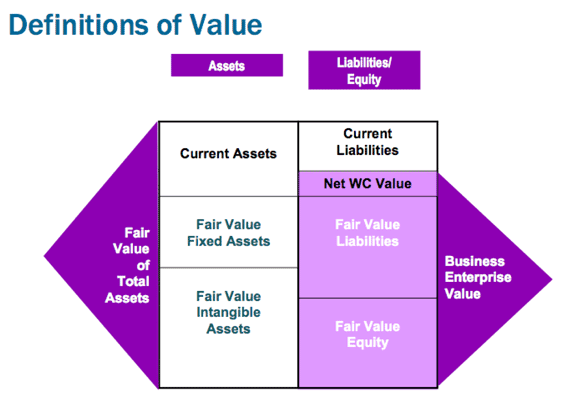
| May 4, 2011 | Issue #104-1 |
It may seem obvious, but don’t forget the balance sheet when valuing small businesses At the beginning of last week’s highly attended BVR webinar, Valuing A Business Worth Less than $2 Million, Kevin Yeanoplos (Brueggeman and Johnson Yeanoplos) told the attendees “I always go back to the accounting equation – that is the key to what we do. I can’t stress this enough.” Using the slide below as an example, Yeanoplos reminded the audience “both sides need to equal. I can’t tell you how many people forget that!” Co-presenter Ron Seigneur (Seigneur Gustafson) agreed, saying that many small business owners have never even looked at a balance sheet.
Co-presenter Michelle Gallagher (Gallagher and Associates) also commented “this slide can be a very useful tool in a trial because it is easy to understand.” To purchase the webinar training pack click here. The use of valuation clauses in estate planning expected to increase In his article “Valuation Clauses: Panacea or Pandora's box?” recently published in Trusts & Estates, Stephen Liss (Withers Bergman LLP) reports that landmark court cases in the past few years support the increased use of valuation clauses in estate planning. He explains:
“It’s time to think about the consequences that taxpayers will have to face when a valuation clause is actually implemented,” the author explains. “The more complicated the underlying investment held by the LLC and the more complicated the financial affairs of the client, the greater the challenges posed by valuation clauses.” DE Chancery still suspicious of company-specific risk and GPCM that relies on ‘meaningless’ comparables Two brothers inherited a large, closely held company from their father. One took active control and 70% of the shares; the other enjoyed his 30% interest over his lifetime, but when he died, distributed his shares to over 165 outsiders. Not surprisingly, the controlling brother authorized a reverse stock split to effectively “squeeze” out the beneficiaries’ fractional interests. They sued, and in an important new decision, the Delaware Chancery Court first ruled that “the fair value standard is…economically efficient and should be applied consistently to freeze-outs,” regardless of whether they take the form of a majority-controlled merger or reverse stock split. More importantly for business appraisers, the court rejected one expert’s use of the guideline public companies method (GPCM), because his selected comparables were too large, more diversified, had better access to capital, deeper management teams, and different economic drivers—so much that they rendered the approach “meaningless” in this case. The court also rejected the expert’s capitalized free cash flow approach because it required too many adjustments. It accepted the capitalized earnings approach used by both experts—but criticized and made its own adjustments for R&D costs, non-recurring revenues, insider self-dealing, tax rate, earnings period, and the capitalization rate. In the latter, the court rejected the 6% company-specific risk premium (CSRP) by one expert because of the “inherent dangers of overestimating” this adjustment, replacing it with a more modest 2%. Download the case digest: Because this is another “must-read” from the DE Chancery, we’ve just added the digest of Reis v. Hazelett Strip-Casting Corp., 2011 WL 303207 (Del. Ch.)(Jan. 21, 2011) to our free downloads page at BVResources. Click here for your copy. May 23 deadline for AICPA’s ABV and CFF certification exams To meet the demand for the ABV and CFF credentials, the AICPA’s Forensic and Valuation Services Section is now offering the ABV and CFF exams for CPAs twice a year. Additional information on the ABV Exam or the CFF Exam is provided on the AICPA website. To help prepare for the ABV exam, there are multiple study aids available, including:
And on another AICPA programming note, the AICPA Family Law Conference takes place in Las Vegas during May 18-20. Valuation practitioners such as Stacy Collins (Financial Research Associates), Tom Hilton (Anders Minkler & Diehl), Ron Seigneur (Seigneur Gustafson), Thomas Burrage (Burrage & Johnson), Stacey Udell (Gold Gocial Gerstein), Michelle Gallagher (Gallagher & Associates), Sharyn Maggio (Maggio & Company) and a host of family law attorneys will share their expertise in the growing fields of family law, valuation and litigation support. DOL is “set” with its position on valuation firms Last week the ESOP Association blogged:
The Association is urging its members to become educated (and vocal) on the DOL’s new definition of who is an ERISA fiduciary. Details on the issue and how and where to respond are here. Damodaran: Agree to disagree about the usefulness of CAPM betas Aswath Damodaran (NYU Stern School of Business) just completed his series on “Alternatives to the CAPM: Wrapping Up.” “Find your own way of adjusting for risk in valuation but refine it and question it constantly,” the professor advises. New Wiley text provides assistance with reviewing valuation reports The article “Reviewing Appraisals: The Devil is in the Details” contains some of the questions and observations contained in the new book A Reviewer’s Handbook to Business Valuation by L. Paul Hood Jr. and Timothy R. Lee (Mercer Capital), including:
Hood and Lee are also the featured speakers in the upcoming BVR webinar “Business Appraisal Reports: Perfecting the Art” on August 11, 2011. Two CPE credits are available. Expert insights on ESOP financial advisor issues The current edition of Insights magazine (Willamette Management Associates) focuses on ESOPs. Three articles are available in full-text:
2011 supplement to Litigation Services Handbook The Litigation Services Handbook, Fourth Edition is often referred to as the litigation bible. The handbook includes all aspects of litigation services, including current environments, the process itself, a wealth of cases, how to prove damages, and practical considerations of court appearances. The just released 2011 cumulative supplement contains new and updated material, including:
For more information or to order, click here. Tomorrow: Join Baker for management projections workshop It’s not too late to join Christine Baker (ParenteBeard) for tomorrow’s “Advanced Workshop on Management Projections and Forecasts,” an in-depth, three-hour event focusing on the uses and abuses of management projections and what every appraiser should know when handling these important, but tricky valuation tools. Through case-studies, live examples, and hands on tutorials, Baker will address how to use projections when they’re at their best, and when they’re incomplete or unrealistic. Baker will be joined by attorney Cynthia Rubin (Flemming Zulack Williamson Zauderer LLP), who will provide invaluable commentary on the legal ramifications of using management projections, be they trustworthy or not. 3.5 CPE credits are available.
To ensure this email is delivered to your inbox, please add editor@bvwire.com to your e-mail address book. We respect your online time and privacy and pledge not to abuse this medium. To unsubscribe to BVWire™ reply to this e-mail with 'REMOVE BVWire' in the subject line or click here. This email was sent to %%emailaddress%% Copyright © 2011 by Business Valuation Resources, LLC |
|




